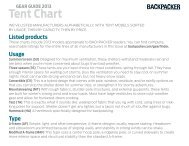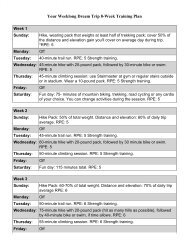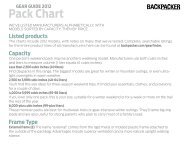BP Get Out More PDF prep
BP Get Out More PDF prep
BP Get Out More PDF prep
Create successful ePaper yourself
Turn your PDF publications into a flip-book with our unique Google optimized e-Paper software.
6. Practice this until you can look at the map, visualize the terrain, and<br />
reach a destination using your map and compass.<br />
BEFORE THE TRIP<br />
■ Check that all seams exposed to weather are taped. If they aren’t, use a<br />
commercial seam sealer to waterproof tents and rainwear. Revitalize<br />
water-repellency treatment on tired raingear and pack covers.<br />
■ Line your sleeping bag’s stuff sack or your entire pack with a<br />
garbage bag.<br />
■ Seal everything—first-aid kit, maps, extra clothes, food, sleeping<br />
pad—in doubled zipper-lock plastic bags.<br />
>>><br />
High-Energy Eats<br />
Sports nutritionists and backcountry-food experts agree that for hikes of up to 1 week<br />
long, a diet of energy-rich carbohydrates with smaller percentages of protein and fat—<br />
about a 40:30:30 ratio—is best. Choose dried and lightweight foods like pasta over <strong>prep</strong>ared,<br />
weighty foods like that super-size can of beef stew. Check the chart below for<br />
other suggestions.<br />
Carbs (40% of diet) Protein (30%) Fat (30%)<br />
bagels canned tuna or chicken cheese<br />
tortillas peanut butter nuts and nut butters<br />
dried fruits and vegetables cheese chocolate and other candies<br />
pasta beans olive and canola oils<br />
rice beef, chicken, or fish jerky beef, chicken, or fish jerky<br />
oatmeal salami, summer sausage salami, summer sausage<br />
granola as cereal or bars nonfat powdered milk cookies<br />
instant mashed potatoes lentils tofu<br />
DURING THE TRIP<br />
■ Look for sheltered camping spots away from drainages on the lee side<br />
of hills or bushes, or in a grove of trees.<br />
■ <strong>Get</strong> dressed and store wet gear in your tent’s vestibule. Use a bandanna<br />
to mop up any droplets that sneak inside that inner sanctum.<br />
■ Keep your sense of humor. Invent or play tent games, write in a journal,<br />
or make up songs about the rain. You’ll be back to the dry life<br />
soon enough.<br />
ATTITUDE CHECK<br />
Longer and more demanding trips tax body and spirit, so take extra care<br />
to keep both healthy.<br />
■ Plan for easy days at the beginning, then add more miles as you get<br />
stronger.<br />
■ Make sure someone at home knows your trip plan, then stick to it.<br />
Before the trip, identify an emergency bailout route midway along<br />
your route.<br />
■ Prevent group dissension by making certain before you go that all<br />
members of the group know their responsibilities. Assign tasks and<br />
write down who’s responsible for the tent, meals, maps and permits,<br />
and so on.<br />
■ If you start to feel angry with a hiking partner, walk by yourself for<br />
a while.<br />
■ Know when to modify your plans. Weather, fatigue, and mishaps add<br />
stress that can ruin a trip if you insist on meeting a difficult goal.<br />
From Weeklong to Long-Distance<br />
Stay out for 2 weeks, 3 weeks, or longer, and you strip life down to its<br />
essence: food, water, warmth, great scenery. Here’s how to enjoy—and survive—the<br />
added blessings and rigors of a long hike.<br />
MAKE IT LAST<br />
Nothing tests the life span of backpacking equipment like a few months<br />
on the trail. Here what’s to expect in terms of wear and tear.<br />
Boots: Long-trail thru-hikers report that sturdy, all-leather boots last (on<br />
average) 1,000 to 1,500 miles before needing to be resoled. Lightweight,<br />
fabric-leather boots, trail shoes, and running shoes last 400 to 1,000 miles.<br />
Break in at least two pairs of footwear before your trip so one pair’s ready to<br />
ship to you if you need a replacement. Include waterproofing treatment for<br />
leather boots in resupply boxes.<br />
Pack: One study of Appalachian Trail thru-hikers found that roughly 40<br />
percent had to have their packs repaired or replaced along the way.<br />
Examine the pack you plan to take for likely wear spots—like straps rubbing<br />
on hard plastic edges and heavily stressed small-gauge zippers—and<br />
evaluate how easy on-trail replacement or repair of the parts would be.<br />
Inspect your pack for wear periodically along the trail, and consider carrying<br />
spare buckles or clevis pins (for external frame packs), as well as duct<br />
tape and upholstery thread with a heavy-duty needle.<br />
36 GET OUT MORE!<br />
WWW.BACKPACKER.COM 37






